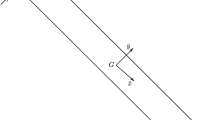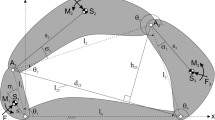Abstract
In the formulation of equations of motion of three-dimensional mechanical systems, the techniques utilized and developed to analyze the electrical networks based on linear graph theory can conveniently be used. The success of this approach, however, relies on the availability of a complete and adequate mathematical model of the rigid body valid in the three-dimensional motion. This article is devoted to the derivation of such a mathematical model for the rigid body as a (k + 1)-port component. In this derivation, the dynamic properties of the rigid body are automatically included as a consequence of the analytical procedures used in the article. In this model, a general form of the terminal equations is given. In many applications, however, its special form, also given in this article, is used.
Similar content being viewed by others
References
F.A. Firestone, “A new analogy between mechanical and electrical systems,”J. Acoust. Soc. Am., vol. 4, pp. 249–267, 1933.
H.M. Trent, “Isomorphisme between oriented linear graphs and lumped physical systems,”J. Acoust. Soc. Am., vol. 27, no. 3, pp. 500–527, 1955.
H.E. Koenig and W.A. Blackwell,Electromechanical System Theory. McGraw-Hill: New York, 1961.
P.H. O'N.Roe,Networks and Systems. Addison-Wesley: Reading, MA, 1966.
H.E. Koenig, Y. Tokad, and H.K. Kesavan,Analysis of Discrete Phsyical Systems. McGraw-Hill: New York, 1967.
J.C.K. Chou, H.K. Kesavan, and K. Singhal, “A systems approach to three-dimensional multibody systems using graph-theoretic models,”IEEE Trans. Syst., Man, Cyber., vol. SMC-12, no. 2, pp. 219–230, 1986.
S. Seshu and M.B. Reed,Linear Graphs and Electrical Networks. Addison-Wesley: Reading, MA, 1961.
S. Duinker, “Traditors. A new class of non-energic non-linear network elements,”Philips Res. Rep., vol. 14, pp. 29–51, 1959.
K.M. Adams, “Applicability of basic concepts in classical network theory to engineering systems,” inPhysical Structure in Systems Theory, J.J. Van Dixhoorn and F.J. Evans (eds.), Academic Press, London, 1974.
J. L. Wyatt and L.O. Chua, “A theory of nonenergic n-ports,”Int. J. Circuit Theory Appl., vol. 5, pp. 181–208, 1977.
H. Goldstein,Classical Mechanics. Addison-Wesley: Cambridge, MA, 1950.
L.A. Pies,Matrix Methods for Engineering. Prentice-Hall: Englewood Cliffs, NJ, 1963.
R.A. Frazer, W.J. Duncan, and A.R. Collar,Elementary Matrices, Cambridge at the University Press: London, 1963.
H. Trent, “On the connection between the properties of oriented linear graphs and analysis of lumped phsyical systems,” J. Res. Nat. Bur. Standards, vol. 698, nos. 1 and 2, pp. 79–84, 1965.
R.W. Newcomb,Linear Multiport Synthesis. McGraw-Hill: New York, 1966.
S.K. Mitra,Analysis and Synthesis of Linear Active Networks. John Wiley & Sons: New York, 1969.
Y. Tokad, “State Variable Technique for the Analysis and Synthesis of Electrical Networks,” inNetwork and System Theory, J.K. Skwirzynski and J.O. Scanlan (eds.), NATO Advanced Study Institute, Bournemouth, September 1972, pp. 83–88.
F. B. Hildebrand, Methods of Applied Mathematics, 2nd edition. Prentice-Hall: Englewood, Cliffs, NJ, 1965.
J.L. Synge and B.A. Griffith, Principles of Mechanics, McGraw-Hill: New York, 1959.
T.C. Bradbury,Bradbury Theoretical Mechanics, John Wiley and Sons: New York, 1968.
Author information
Authors and Affiliations
Rights and permissions
About this article
Cite this article
Tokad, Y. A network model for rigid-body motion. Dynamics and Control 2, 59–82 (1992). https://doi.org/10.1007/BF02169806
Received:
Revised:
Issue Date:
DOI: https://doi.org/10.1007/BF02169806




